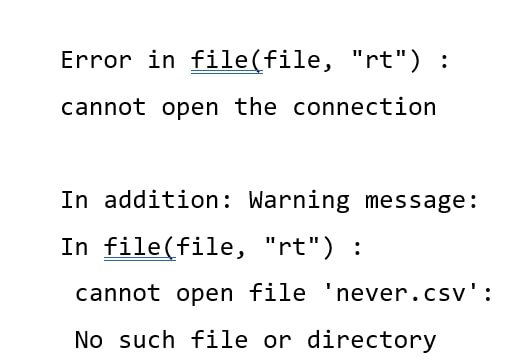Error in the “file(file, “rt “): cannot open the connection” typically indicates a problem opening a particular Excel file or R code file. So, I strongly recommend that programmers need to know how to take care of them. Let’s learn.

Key Takeaways
- The “error in the file(file, “rt”)” in the error message is related to a problem with opening a particular Excel file or R code file and a low-level function used to open it.
- This common R file access problem occurs when you attempt to open a data file, but R cannot locate it.
- You can fix this by using setwd() and read.csv.
I’ve tested these fixes for this issue:
- Using setwd()
- Using read.csv
Using setwd()
You need to move to the directory where the never.csv file is placed. You can do this using the setwd() function:

Using read.csv()
Instead of going to that directory, you can give the file’s complete path. Here’s how to do that:

Additional Tip
Now you might be wondering, “My code’s lengthy, and I don’t know where to start from. It’s all so overwhelming; what do I do?” Well, here are some things to keep in mind while debugging your code:
- Verify that the issue is the working document’s wrong placement in your R file.
- Make the file compatible with Windows and examine all pertinent data suffixes.
- Verify the correct location for your files and all pertinent R file references in your documents.
- If you plan to download from a remote server drive, ensure the download works.
- BEWARE! Syntax errors will often sneak up on you. Check for them.
- R may occasionally have problems with Excel documents, so ensure the package settings are correct.
Final Verdict
To fix the “error in the file(file, “rt”),” use setwd() or read.csv. These methods, validated through testing, involve directory navigation or providing complete file paths. For efficient debugging, confirm file placement and compatibility and watch for syntax errors in lengthy code.
Here are some other guides that might come in handy:
- ‘\u’ Used Without Hex Digits In Character String Starting” c:\u.”
- Vector Memory Exhausted Error
- Error: Unknown Command: Cask
Frequently Asked Questions
What is read.csv?
read.csv() is a wrapper function for read. table() that takes the first line of the input file as a header to specify the table's column names and requires a comma as the separator. It is a perfect contender to read CSV files because of this.
What is setwd()?
A built-in function in R called setwd makes the current directory the working directory. An argument for the setwd() method is a new working directory. Use the setwd() function in R to alter the current working directory. The data directory is typically navigated using the setwd() method.
What is code debugging?
In computer programming and engineering, debugging is a multi-step process that entails locating a problem, tracking down the source of the problem, and either fixing the problem directly or finding a workaround. Testing the fix or workaround to make sure it functions is the last stage in the debugging process.
When a developer is able to find and reproduce a code error in a computer programme, the debugging process in software development gets started. The software testing process, as well as the full software development lifecycle, includes debugging.
What's the R foundation?
A nonprofit organisation serving the public good, The R Foundation. The R Core Team established it to support the R project and other statistical computing advances, provide a resource for people, organisations, or businesses looking to assist or engage with the R development community, and hold and manage the copyright of R software and documentation.
What functionalities does R offer?
R, which is primarily an interpreted programming language, supports branching, looping, and modular programming via functions. R was used to construct the vast bulk of its user-visible functionality. For increased effectiveness, the user can interact with methods written in C, C++, or FORTRAN. Numerous statistical methods are supported by the R distribution.
There are several of them, including time series analysis, linear and modified linear models, nonlinear regression models, smoothing, grouping, and traditional parametric and non-parametric testing. Additionally, a sizable number of elements offer a flexible graphical framework for designing different data displays.
Is R Free?
The programming libraries for R are all open-source, but Revolution Analytics derives its revenue from its service packages that give customers access to the libraries the company creates in-house. This means that the language itself is completely free to use.
Good job! Please give your positive feedback
How could we improve this post? Please Help us.